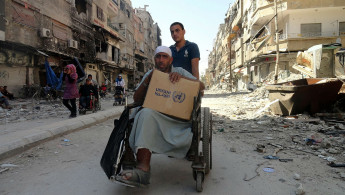'Siege': Nine minutes in Yarmouk
Many films have depicted the suffering of war, and the harshness of a life under siege. They often convey a sense of oppression, destruction and despair - the essential ingredients of war cinema.
However, Siege, the nine-minute short film about the siege of Yarmouk refugee camp in Damascus, does not conform to this formula of war cinema.
The film took four months to complete after its besieged directors, all Yarmouk residents, received training over Skype on how to make films.
The film does not try to shock the viewer or manufacture false sympathy or emotion - instead it gives intimate insight into the lives of the refugee camp's besieged residents.
Siege weaves four stories together to give a first hand account of the camp. Dana, the title and subject of the first story, outwits her small and thin body to push large containers of water on a small cart, which she skillfully transfers into buckets.
Dana does not talk about her lost dreams or her lost childhood as she is forced to carry water containers instead of playing or studying. If you listen carefully you will hear her hold her breath as she carries the heavy containers. You will sense the cold. She will remind you she is there in all her being, breathing, exerting, alive and determined, despite the greyness around her.
The second sub-story, titled Ampere, shows a critical time before and after electricity briefly returns to the camp.
As soon as the lights come back on, young men rush for their mobile phone chargers and gather their clothes to be washed. The voice of one man dominates the scene as he insistently asks where the electric shaver is.
The young man's voice evokes a sense of hope: under a merciless siege, in a life that is anything but a life, there is still a young man in Yarmouk refugee camp looking for a shaver to pass over his bestubbled face.
Yarmouk bus station is the only narrated story. The narrator reminds us of the bus route that used to connect the refugee camp with the centre of Damascus, as we look at pictures of a burnt-out minibus.
The narrative is more effective than the images: you cannot help but smell the scents being described and hear the noise of the minibus and its passengers.
In the fourth and final sub-story, colour is the most expressive feature. A lively green almost distracts the viewer from the distant sounds of shelling. We later discover we were looking at the green leafs of a radish plants growing in between the buildings. Small green plots are planted and cared for by Yarmouk's residents.
The film does not try to summarise or document the situation in the camp, which would take hours of footage to capture properly. Instead, in its nine minutes of grey and green, cold and sun, it comes close to touching the spirit of Yarmouk and its people.
This is the same spirit that pushed its creators to complete the film - despite one of its creators and one of its directors being tragically killed, while the rest of the film's team wait for their fate to become known.
This article is an edited translation from our Arabic edition.



